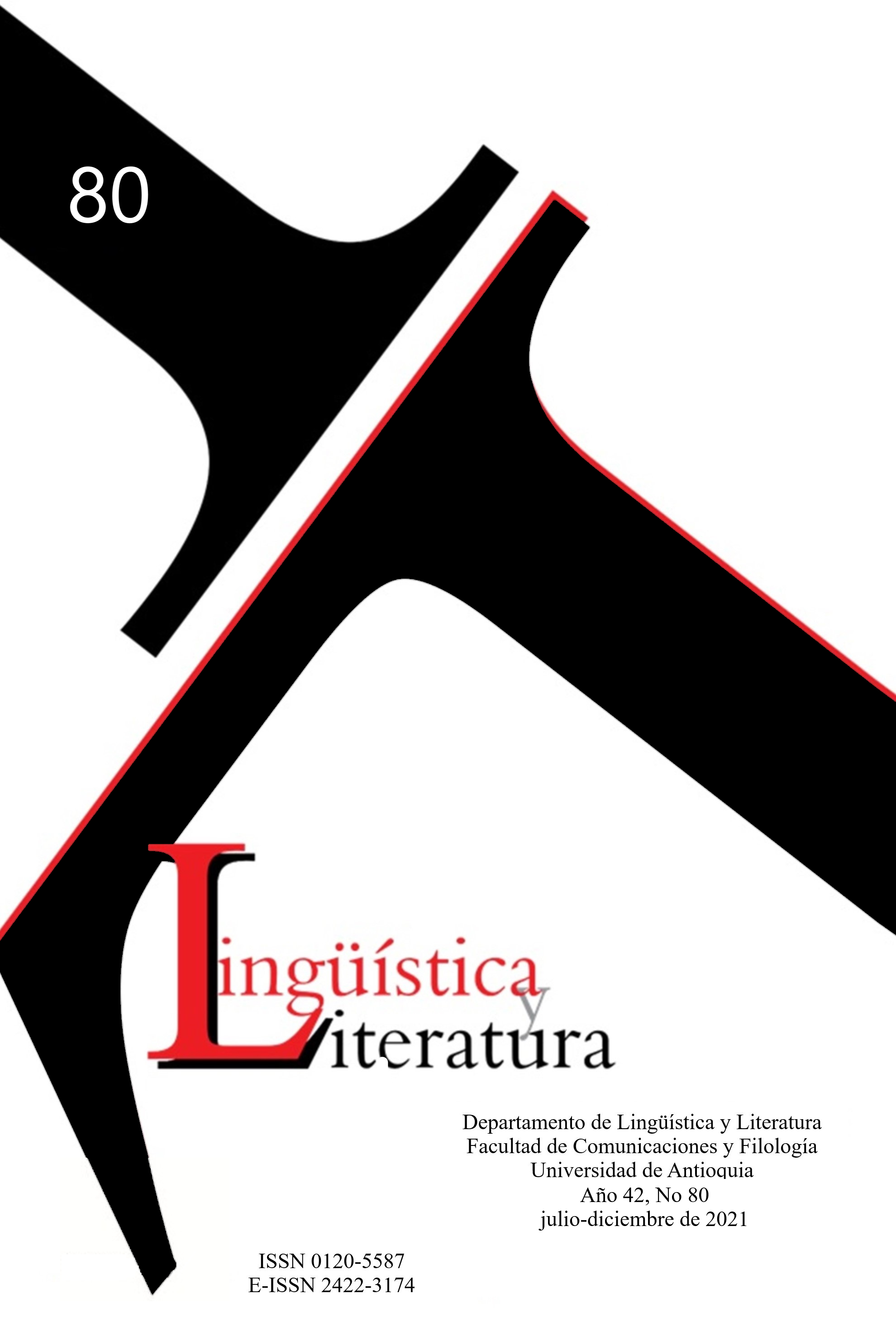Verbal Lexical Patterns in the Expression of Motion Events in Yaqui Language
DOI:
https://doi.org/10.17533/udea.lyl.n80a16Keywords:
Yaqui language, motion verbs, motion events, lexical patternsAbstract
In this work, we show that in Yaqui language it is possible to distinguish four lexical patterns: i) motion and path; ii) motion and manner; iii) motion, path and cause; and iv) motion, path and figure. Likewise, we determine that the occurrence of lexical patterns has implications in the syntactic structure of movement events, because the events with lexical patterns i), ii), and iv) have intransitive syntactic structures, where the figure corresponds to the subject of the sentence. Meanwhile, the events with a lexical pattern iii) have transitive syntactic structures, where the figure corresponds to the direct object.
Downloads
References
Bejípone Cruz, M. (2013). Préstamos lingüísticos en la lengua yaqui. (Tesis de maestría). Hermosillo: Universidad de Sonora.
Dedrick, J. & Casad, H. (1999). Sonora Yaqui Language Structures. Tucson: University of Arizona Press.
Estrada-Fernández, Z., Buitimea Valenzuela, C., Gurrola Camacho, A., Castillo Celaya, M. y Carlon Flores, A. (2004). Diccionario yaqui-español y textos. Obra de preservación lingüística. Hermosillo: Plaza y Valdéz/Universidad de Sonora
Estrada-Fernández, Z., Carlón Flores, A. y Gutiérrez Estrada, M. R. (2018). Jeka Aniata jiapsi: Jiak jamutta etejoi. / Vida de Jeka Ania: Historia de una mujer yaqui. Hermosillo: Universidad de Sonora.
Estrada-Fernández, Z., Tubino Blanco, M., & Villalpando Quiñonez, J. (2013). Yaqui valency patterns. Valency Patterns Leipzig. Leipzig: Max Planck Institute for Evolutionary Anthropology. www.valpal.info/languages/yaqui
Guerrero, L. (2014). Verbos de movimiento y predicados complejos en yaqui. En L. Guerrero (Coord.), Movimiento y espacio en lenguas de América (pp. 238-275). México: Universidad Nacional Autónoma de México.
Hernandez, G. (2002). Marcadores discursivos: una exploración en la narrativa yaqui (Tesis de Maestría). Hermosillo: Universidad de Sonora.
Ibarretxe-Antuñano, I. (2009). Path Salience in Motion Events. In J. Guo, E. Lieven, N. Budwig, S. Ervin-Tripp, K. Nakamura, & S. Őzçalişkan (Eds.), Crosslinguistic Approaches to the Psychology of Language: Research in the Tradition of Dan Isaac Slobin (pp. 403-414). New York: Psychology Press.
Imbert, C. (2012). Path: Ways Typology Has Walked Through It. Language and Linguistics Compass, 6(4), 236-258.
Lerma Rodríguez, E. (2014). Algunas consideraciones sobre investigación etnográfica en la tribu yaqui. Culturales, 2(2), 41-62.
Levin, B. (1993). English Verb Classes and Alternation. A Preliminary Investigation. Chicago: University of Chicago Press.
Lindenfeld, J. (1973). Yaqui Syntax. Los Angeles: University of California Press.
Martínez, D. (2015). El sufijo -ta en yaqui: redireccionando su clasificación (Tesis de Maestría). Hermosillo: Universidad de Sonora.
Martínez, D. (2021). Los eventos de movimiento en yaqui (Tesis de Doctorado). Hermosillo: Universidad de Sonora.
Moctezuma Zamarrón, J. (2007). Yaquis. Comisión Nacional para el Desarrollo de los Pueblos Indígenas.
Talmy, L. (1985). Lexicalization Patterns: Semantic Structure in Lexical Forms. Language Typology and Syntactic Description, 3(99), 36-149.
Tubino Blanco, M. (2010). Las causativas léxicas del yaqui. En Z. Estrada y A. Álvarez (Eds.), Estudios de lenguas amerindias (pp. 235-252). Hermosillo: Universidad de Sonora.
Published
How to Cite
Issue
Section
License
Copyright (c) 2021 Linguistics and Literature

This work is licensed under a Creative Commons Attribution-NonCommercial-ShareAlike 4.0 International License.
Creative Commons by-nc-sa
Those authors who have publications with this journal, accept the following terms:
1. The journal is the owner of the copyright of the articles, which will be simultaneously subject to the Creative Commons Attribution-NonCommercial-ShareAlike 4.0 International License. that allows third parties to share the work provided its author is indicated and its first publication in this journal.
2. The authors may adopt other agreements of non-exclusive license of distribution of the version of the published work (e.g., deposit it in an institutional telematic file or publish it in a monographic volume) provided that the initial publication in this journal is indicated.
3. Authors are allowed and recommended to disseminate their work via the Internet (e.g. in institutional telematic files or on their website) before and during the submission process, which can produce interesting exchanges and increase citations of the published work.










